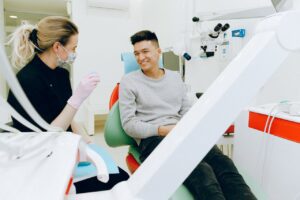Outpatient procedures are on the rise, and for good reason. They’re excellent ways to get taken care of without making it a stressful environment for you or your loved one. However, there are different outpatient procedures out there, and not everyone understands what they are or how they’re offered.
To learn more about common outpatient procedures, keep reading. We’re going to break down the most common ones you should know about so that you can get a better understanding of them. Once you do, we promise you’ll look at them with new eyes.
1. Cataract Surgery
Cataract surgery is one of the most common outpatient procedures. A cataract is a clouding of the lens of the eye that affects vision. Cataract surgery involves removing the clouded lens and replacing it with an artificial intraocular lens (IOL). During the procedure, the ophthalmologist makes a small incision on the side of the eye. The cataract is then removed, and the IOL is implanted.
The procedure itself usually takes about 30 minutes, and most patients can resume daily activities within a few days. Cataract surgery has a very high success rate, and most people experience improved vision and greater mobility after surgery. For many individuals, cataract surgery is life-changing, as it can significantly improve vision and quality of life.
2. Sclerotherapy
Sclerotherapy is one of the most common outpatient procedures for treating spider veins, small varicose veins, and larger varicose veins. While not suitable for the most severe cases of venous insufficiency, sclerotherapy has proven to be an effective, safe, and generally non-invasive procedure for treating large, small, and reticular veins.
Sclerotherapy is an economical yet effective way to reduce the appearance of unsightly blemishes on the legs and other areas of the body. Patients need to be aware of the various side effects of sclerotherapy, such as mild discomfort, itching, and redness, before undergoing the procedure.
3. Septoplasty
Septoplasty is a common outpatient procedure used to correct a deviated septum. A deviated septum is when the wall between the two chambers of the nose becomes crooked, blocking one or both sides of the nose. Septoplasty is used to straighten the septum, opening up the nasal airways and allowing for better airflow and easier breathing.
The procedure involves reshaping the outer portion of the septum to restore a normal structure. This procedure is generally performed as an outpatient procedure, meaning no overnight hospital stay is required. During the procedure, the doctor may use one of several techniques, including nasal endoscopy, cartilage removal, or surgery to open the nasal airways.
Recovery from septoplasty usually takes several weeks, during which time the patient may need to avoid strenuous activities. After a successful septoplasty, patients are able to breathe easier and experience less congestion and headache pain.
4. Tonsillectomy
A tonsillectomy is one of the most common outpatient procedures, and it involves the removal of the tonsils. This is typically done to treat severe throat infections or a condition like sleep apnea. During the procedure, the doctor will remove the patient’s tonsils with specialized instruments. For those who have a serious throat infection or sleep apnea, the tonsils will be completely removed, as they won’t be able to heal properly from a partial removal.
After the procedure, patients may experience a sore throat and have difficulty speaking and swallowing, but this should improve within a few weeks. Since it is an al outpatient surgery procedure, the patient can typically go home shortly after the tonsillectomy is completed.
5. Hip and Knee Arthroplasty
Hip and Knee Arthroplasty are two of the most common outpatient procedures in orthopedic surgery. It involves a joint replacement procedure, where a surgeon surgically removes the damaged bone and cartilage and then replaces it with an artificial one made of metal or a very strong plastic material.
The specific joint being replaced depends on the patient’s age and activity level, as well as on the amount of damage to the original joint. It offers the patient increased mobility and often relieves the pain and stiffness associated with an arthritic joint.
Typically, hip and knee arthroplasty nonoperative procedures are performed under general anesthesia, with recovery times of four to six weeks and a full recovery in three to five months. Rehabilitation may involve physical and occupational therapy sessions to regain strength, flexibility, range of motion, and balance.
6. Rotator Cuff Repair
Rotator cuff repair is a common outpatient procedure for shoulder pain. It is performed when the tendons or muscles around the shoulder become injured or torn. The goal of the procedure is to alleviate pain, restore movement and improve shoulder function.
The procedure usually involves a surgeon making an incision in the shoulder and then repairing the damaged tendon or muscle or reattaching it to the bone. Recovery time for rotator cuff repair varies depending on the extent of the injury and the age of the patient.
Generally, it takes up to six weeks for the shoulder to fully recover. Physical therapy is expected to help the patient regain full range of motion. Rotator cuff repair may also be used to help prevent similar further injuries to the shoulder in the future.
7. Cardiopulmonary
Cardiopulmonary procedures are among the most common outpatient procedures performed today. These procedures assess the patient’s heart and lung health and can be conducted in a number of different ways, including electrocardiograms (ECGs or EKGs), chest X-rays, echocardiograms, and pulmonary function tests.
ECGs monitor the heart’s electrical activity and are especially useful in identifying arrhythmias. Chest X-rays can detect abnormalities in the heart, lungs, and surrounding structures, while echocardiograms allow doctors to evaluate the heart’s structure and function.
Pulmonary function tests measure how well the lungs are able to perform and are used to diagnose diseases like asthma or COPD. Each of these cardiopulmonary tests provides valuable information about the patient’s overall health and can aid in the diagnosis and treatment of conditions like heart disease or lung cancer. Check a cardiopulmonary center to get this started.
Learn More About Outpatient Procedures
Overall, outpatient procedures can save time, money, and stress. It is important to educate yourself on common outpatient procedures and the risks and benefits associated with them. Doing so can help ensure you receive the best care possible.
Did you find this article helpful? Check out the rest of our blog for more!









